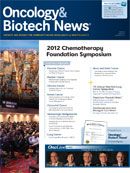Publication
Article
Oncology & Biotech News
Local Ablative Therapy Might Extend TKI Benefit in NSCLC
Author(s):
Local ablative therapy plus continuation on the same tyrosine kinase inhibitor could be utilized as a treatment alternative in metastatic non-small cell lung cancer.
Andrew J. Weickhardt,
MBBS, DmedSc
Patients with metastatic non—small cell lung cancer (NSCLC) often experience disease progression after receiving a tyrosine kinase inhibitor (TKI) as a targeted treatment. While there is no guideline on what to do once this progression occurs, chemotherapy is often used as a second-line treatment. In a recent study, Andrew J. Weickhardt, MBBS, DmedSc, University of Colorado Cancer Center, Aurora, and colleagues examined whether local ablative therapy (LAT) plus continuation on the same TKI could be utilized as a treatment alternative in this setting.
Metastatic NSCLC patients with rearrangements of ALK or mutations of EGFR have high response rates and long periods of progression-free survival (PFS) when treated with crizotinib and erlotinib, respectively. However, patients often progress after these targeted therapies are administered, due to changes in the tumor, such as the development of new kinase domain mutations in the drug target or the development of alternate oncogenic drivers. Additionally, in some cases, the drug is unable to penetrate the central nervous system and the disease will progress into the brain.
Weickhardt et al studied patients with mutations of either ALK or EGFR who were subsequently treated with crizotinib or erlotinib, respectively, at the University of Colorado Cancer Center between May 2005 and December 2011. When these TKI drugs were given as initial therapy, the PFS of patients who were ALK-positive and received crizotinib was 9.0 months, and patients who were EGFR-mutant and received erlotinib had a median PFS of 13.8 months.
During that period, 51 patients experienced disease progression after TKI therapy. Of those patients, 25 (49%) were deemed suitable for LAT with either radiotherapy (n = 24) or surgery (n = 1) along with continuation of the same TKI therapy. After LAT, 19 of the 25 patients progressed, this time experiencing a median PFS period of 6.2 months in addition to the previous period of PFS achieved with frontline TKI therapy.
The researchers noted that a more substantial benefit was observed in patients whose disease had progressed only to the brain. There were 10 patients total in the study in which the brain was the site of first progression. In this subgroup, the median PFS with frontline TKI therapy was 10.9 months. When these patients received LAT after their first progression, the second median PFS was 7.1 months, a slightly higher period of PFS than observed in the total study population.
The authors noted that their study had limitations. The research was conducted using only patients seen at a single cancer center, so the authors suggest that while the study is encouraging, it should serve as a basis for more complete studies in the future. Additionally, the study did not use a comparator, such as chemotherapy, to determine whether continuation on TKI therapy is truly superior to chemotherapy.
“We strongly advocate that to delineate the true extent of benefit, a prospective trial is required across multiple centers with defined treatment criteria and standardized restaging technology (PET/MRI) should be used at defined intervals to minimize bias,” the authors wrote.
Weickhardt AJ, Scheier B, Burke JM, et al. Local ablative therapy of oligoprogressive disease prolongs disease control by tyrosine kinase inhibitor in oncogene-addicted non-small-cell lung cancer. J Thorac Oncol. 2012;7(12):1807-1814.
































%20(2)%201-Recovered-Recovered-Recovered-Recovered-Recovered-Recovered-Recovered-Recovered-Recovered-Recovered-Recovered-Recovered-Recovered-Recovered-Recovered-Recovered-Recovered.jpg?fit=crop&auto=format)
%20(2)%201-Recovered-Recovered-Recovered-Recovered-Recovered-Recovered-Recovered-Recovered-Recovered-Recovered-Recovered-Recovered-Recovered-Recovered-Recovered-Recovered-Recovered.jpg?fit=crop&auto=format)
